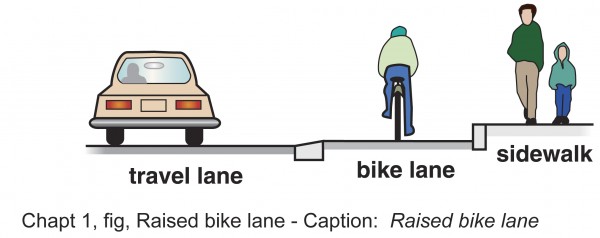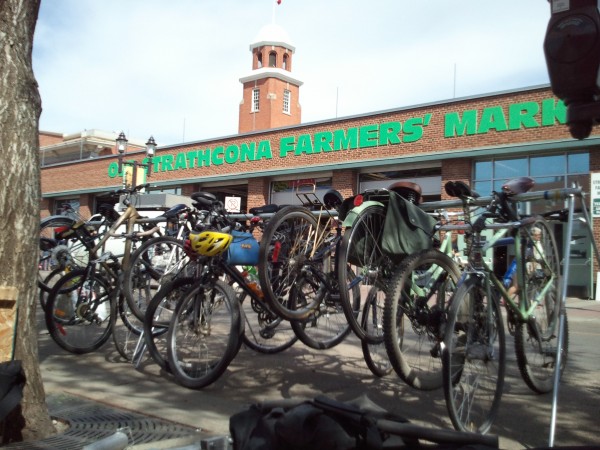Cycling in downtown Edmonton is a bit like jogging with bulls. Each time you’re nearly crushed riding atop your velo, you wonder if it wouldn’t be smarter to join the herd and buy a car. Bike lanes (protected or not) are in our downtown future and cyclists should rejoice. But the lanes are also years away, meaning that for the time being, we cyclists must ride on multi-lane streets where the bulls run free.
Thankfully, making the streets safer for Edmonton’s bike commuters is possible right now, and cheaply, too, with a few changes. Here are four ideas to get us there.
One: Move parking to the left

They’re called buffered bike lanes and they use cars to protect cyclists – no, really. On a typical street with a bike track, said lane is usually placed to the left of street-side parking areas. But cities like New York (and soon, Portland) have reversed this, putting bike lanes to the right of parked cars and to the left of the street curb. The benefits to this rearrangement are that parked cars provide a physical barrier between traffic and cyclists, without requiring hard infrastructure or using an inch of additional space. Think of the idea as a protected bike lane on the cheap.
Of course, the potential frustrations are also clear – taxis, buses and other vehicles will doubtlessly pull to the curb and into the new bike lane rather than stop to the right of the parking zone. And car doors will still be an issue for cyclists. There’s also the not-so-simple need to reconfigure our streets. Still, this is one idea that potentially costs relatively few bucks for the bang it delivers. It would also be (relatively) easy to introduce on multi-lane or wide streets that already have bike lanes – think 121 St. between 104 Ave. and Jasper.
Two: Figure out bikes on sidewalks

Look. As a pedestrian and a cyclist, I dislike sidewalk cyclists. But cyclists in Edmonton seem intent to ride on sidewalks, and who can blame them – because riding on roads, with the bulls, just seems too dodgy (though, if you look at the research, it’s actually safer). Regardless, finding a way to integrate cyclists and pedestrians on one street-side bit of infrastructure is tough. One option, popular in Germany, is raised bike lanes (essentially, they’re sidewalks) with a further raised area for pedestrians. This could easily be incorporated along the planned sidewalk widening of Jasper Avenue to the west of 109 St. Another idea is to watch where cyclists are already using sidewalks (again, think Jasper, 102 Ave., 104 Ave.) and determine where pedestrians and cyclists are tangling most often. Wherever that is, paint some lanes and at least show people where to go to avoid one another.
Three: Rolling stops and smarter lights
Since 1982, Idaho has allowed cyclists to treat stop signs as yields and red lights as stop signs. In 2012, Paris followed suit with a similar law. The thinking is this: when a cyclist approaches an intersection with a stop sign, there’s often no traffic requiring they stop. Forcing them to do so, to obey the law, ruins their most valuable resource – momentum. That’s a disincentive to cyclists who want to play by the rules designed for cars.
When it comes to a red light, allowing a cyclist to proceed through an intersection before allowing cars to do so allows cyclists to get ahead of the main clutch of traffic waiting behind them at the light. It also allows them out of the danger zone at intersections. Sitting at the curb on a red light on a bike, while impatient drivers are trying to turn right on a red, is dodgy to say the least. This would surely be contentious – motorists often think cyclists behave with little regard for rules as it is.
And on lights, could we at least think about timing on certain downtown streets? A ride down 102 Ave. in the morning sees little traffic but lights timed near perfectly to catch cyclists (not to mention pedestrians) at each intersection. The lights are timed for car speeds, not bike speeds. That could easily be changed.
Four: Ban big trucks from some downtown streets
The drivers of garbage trucks, dump trucks, semis and other machinery struggle to see cyclists from their elevated perches. We could easily figure out routes that can allow them to do their needed work but prevent them from crushing our cyclists in the downtown core. If you have ever nearly been run over on your bike by a truck, as I have, you would struggle to see how cyclists and trucks can safely integrate. Why risk it? Get the trucks off streets designated as cycle-friendly.


7 comments
The traffic light timing issue gets even “better” when the lights are triggered by vehicle sensors. Crossing 105 St North of downtown, at the intersections reconfigured for the new LRT tracks, I’ve sat at a couple of intersections where I swear the full cycle of the lights goes by without the crossing ave getting a green – because a bicycle is too small to trigger the vehicle sensor. Only when a car pulled up alongside me did the next light cycle contain a green for us.
I love the idea of raised bike lanes. I cycle occasionally, but mainly I walk and take transit with my toddler. I would cycle more but I’m afraid to do so with my toddler (who I bring south across the river to daycare every day). I don’t feel safe cycling around the hospital and university: there’s hardly any cycling infrastructure, and I would feel wrong about cycling on the sidewalks with a Chariot.
As a pedestrian, my biggest challenge is walking the three block stretch around the Health Sciences LRT station, which is used frequently by both cyclists and pedestrians. I’ve been nearly bowled over twice, once carrying my then-baby. (Sidenote: cyclists should at least use their bells when passing pedestrians on sidewalks!) What I’d really like to see is better-designed sidewalks/bike lanes around lrt stations. I think raised bike lanes are a good solution. It would be great if this could be implemented near new stations.
Really hoping people from the city are reading these comments as positive and useful feedback rather than criticism. Great thoughts, Mark and Jana.
I like the idea of stop lights as stop signs. That would be great. And I agree with Jana, the bike routes around LRT stations should be improved. Like arround Southgate Station where if you are heading south, you have to cross the tracks to get to the multi-use trail or ride against traffic on the sidewalk and brave the “no ride” zone of the bus terminal.
I’ve recently heard the good form of timing you describe in point #3 called a “green wave.” Lord, I’d love to see that on 100th Ave. I HATE cycling downtown (where I live) because I have to stop at EVERY goddamn light.
How about we finish the bike routes…
for one i refuse to ride on Major arterial roads like Stony Plain Road and 102Ave (cept now that its closed) its not fair to the automobiles going 2ce the bike speed. and its not fair to force bikes onto these major routes for our safety. (and slowing down all these cars certainly does nothing for the image problem cycles have). What we do have in this city are a few really good multi use paths….. riddled with horrible design. take 178st multi-use path for example. its great until you reach a few intersections that don’t even have lowered curbs. both killing your back and your momentum. and around West Edmonton mall is the worst area for bikes in this city with no pedestrian or bike thoroughfares at all. then we have a few bike routes like 95th ave to downtown… that where it crosses 142 st. you have to use a small pedestrian bolivard cross.. try doing that thing at 25km/h… i completely understand that bikes should use the service roads. (should be done better then a stop sign every block and more people would use them) but make accessing the bike route easier then it currently is.
a second raised sidewalk idea is maybe a good idea.. but its far from cheap.
Cheap economically perhaps, but not cheap politically in this town